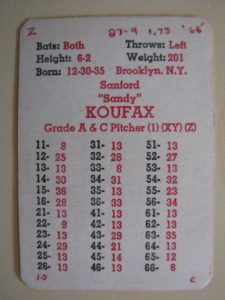Some players are like shooting-stars, springing on the scene for a season or two and then disappearing into obscurity. Each generation of baseball seems to have a handful of such players: Lyman Bostock, J.R. Richard, Mark Fidrych, Bo Jackson, Dwight Golden, Mo Vaughn, Mark Prior, and Josh Hamilton are a few that come to mind. Yet, only one player in MLB history is like Halley’s Comet…Sandy Koufax. Since his retirement nearly 52 years ago, baseball hasn’t seen a player like Koufax. Maybe we need to wait 23 more years for the Koufax’s Comet to return.
| Split | W | L | W-L% | ERA | G | GS | CG | SHO | IP | H | R | ER | HR | BB | SO | HBP | BK | WP | WHIP | SO9 |
|---|---|---|---|---|---|---|---|---|---|---|---|---|---|---|---|---|---|---|---|---|
| 1966 Totals | 27 | 9 | .750 | 1.73 | 41 | 41 | 27 | 5 | 323.0 | 241 | 74 | 62 | 19 | 77 | 317 | 0 | 0 | 7 | 0.985 | 8.8 |
Sandy Koufax’s final APBA card is brilliant. It’s the best final season anyone ever produced. Koufax had a 10.3 WAR! For his remarkable season, APBA awarded him an A&C rating with a XYZ. Koufax pitched, a now amazing, 323 innings with 27 complete games. Five of those complete games were shutouts. Sandy averaged nearly eight innings and nine strikeouts a start, and he lead the league in wins, ERA, strikeouts, innings pitched, games started, complete games, and shutouts. He won the pitching Triple Crown and Cy Young Award, which for the last time in 1966, was only awarded to a single pitcher in baseball.
Even more amazing than his statistics were the conditions under which he produced them. By 1966, Koufax had been dealing with chronic arm problems for four years. After injuring a finger on his pitching hand in 1962 that resulted in numbness and a serious blood clot, Koufax was diagnosed with traumatic elbow arthritis the following season. Despite these injuries and constantly dealing with the pain, Sandy produced a remarkable five year run of dominance. During his final five seasons, Koufax was 111-34 with a 1.95 ERA. Unbelievably, in his first six seasons, he was 36-40 with a 4.10 ERA. In today’s game, a player would not be given six seasons to find his stride. Luckily, Koufax played in a different era.
There are several theories for Koufax’s turnaround, but the truth is probably a combination of them all. There were a few keys to his success. First, he became a pitcher and not a thrower. Instead of trying to overpower hitters with his fastball, he focused on getting ahead of batters and setting them up for his devastating curveball. Notice that he only walked 77 hitters in 323 innings in 1966 and that he didn’t hit any batters. Second, he pitched in Dodger Stadium, a pitcher-friendly ballpark. Finally, he pitched in the early expansion era. It didn’t hurt Koufax to get a few starts against the New York Mets and the Houston Astros. Even so, Koufax’s final five seasons were a thing of beauty that the baseball world was privileged to witness.
It was a shock when Koufax announced his retirement in the fall of 1966. However, in hindsight, his decision was completely understandable. He was told before the season that if he continued to pitch he risked permanent and crippling damage to his arm…possibly even amputation. Before every game, he took pain medication and threw every inning in pain. By his final season, his left arm was shorter than his right and he had to have his suits specially tailored to compensate. After a contentious contract negotiation to start the season, the 30-year old Koufax probably reassessed his priorities and how he wanted to live the rest of his life. Courageously, he decided it was time to walk away.
Because he left at the top of his game and stardom, the legend of Sandy Koufax has grown to mythical proportions in the past five decades. Like The Beatles breaking up when they were still on top of the rock’n roll world, Koufax’s star continues to burn bright with speculation about what might have been. Baseball fans will continue to speculate until the Koufax Comet returns one day.
Special thanks to Pastor Rich Zawadzki for suggesting this card and providing the photo.





Do you really think it fair to mention Lyman Bostock a blip on the radar of stardom? after all, the man was killed in mid-season.
Yes, I do. I certainly meant no disrespect. The point is, he was only a star for about three seasons. There’s always a reason for a player’s fall from stardom. Usually it’s an injury, like in the case of Bo Jackson, Mark Prior, or Mark Fidrych. By the way, Fidrych also died tragically years after he retired. Also, it’s not like I’m trying to poke fun at Dwight Gooden’s or Josh Hamilton’s drug problems by mentioning them. Nor am I making light of J.R. Richard’s stroke. Things happen. Players need a combination of luck and good decisions to have longevity.
Excellent article.
GREAT ARTICLE!…My favorite player.